Grips & Supports
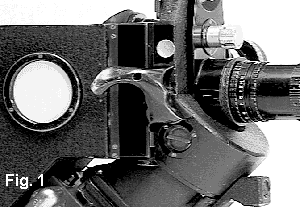 Getting a good grip on the Eclair NPR
has never been an easy task. For almost 60 years, filmmakers have struggled
with finding a way to hold onto the camera. If the sheer 20 pound weight
were not enough, the camera was also very front heavy. Since the bulk of
the mechanism is so far forward, it has a natural tendency to want to fall
off your shoulder. To make matters worse, the rather silly little thumb
& nuckle grip (fig. 1) that came with the camera from the factory
was nothing more than a joke.
Getting a good grip on the Eclair NPR
has never been an easy task. For almost 60 years, filmmakers have struggled
with finding a way to hold onto the camera. If the sheer 20 pound weight
were not enough, the camera was also very front heavy. Since the bulk of
the mechanism is so far forward, it has a natural tendency to want to fall
off your shoulder. To make matters worse, the rather silly little thumb
& nuckle grip (fig. 1) that came with the camera from the factory
was nothing more than a joke.
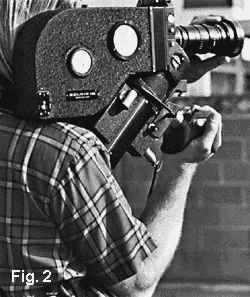 It was located
in an awkward position that forced your right arm to extend upwards away
from your body causing you to have to stiff-arm almost the full weight for
hours on end. Needless to say, filmmakers did complain. Fortunately, Eclair
and other third party companies eventually came forward with various gizmos
to help out the weary cameraperson. Some of the most popular of these are
shown, here. If there are others I have not included, please send me an
email.
It was located
in an awkward position that forced your right arm to extend upwards away
from your body causing you to have to stiff-arm almost the full weight for
hours on end. Needless to say, filmmakers did complain. Fortunately, Eclair
and other third party companies eventually came forward with various gizmos
to help out the weary cameraperson. Some of the most popular of these are
shown, here. If there are others I have not included, please send me an
email.
Sometime around mid-1970, Eclair offered
a rather elaborate contraption they called the "Horizontal Palm Rest Handle"
(fig. 2). It worked by grabbing onto the two Frankenstein-style studs made
for the tripod cradle and used a steel spring bungee to secure it to the
bottom face of the motor. Since most filmmakers tended to support the NPR
by holding onto the front of
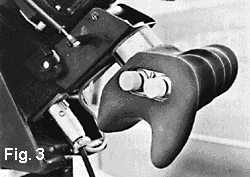 the motor just
under the socket for the matte-box rod, this design seemed to make the most
sense since your arm was now centered under the weight of the camera and
could rest rather comfortably against your waist. The natural shape of the
grip matched that of the human hand making it easier to support the camera
for extended periods. Two pushbuttons were provided (fig. 3) to allow for
control of the motor start/stop and some other accessory.
the motor just
under the socket for the matte-box rod, this design seemed to make the most
sense since your arm was now centered under the weight of the camera and
could rest rather comfortably against your waist. The natural shape of the
grip matched that of the human hand making it easier to support the camera
for extended periods. Two pushbuttons were provided (fig. 3) to allow for
control of the motor start/stop and some other accessory.
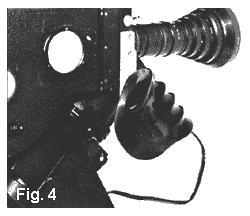 The Victor Duncan company, a large film equipment sales and
rental film, offered their version of an Eclair NPR grip sometime around
1975 (fig. 4). It was mounted to the right-hand side of the camera using
the existing screw holes for the factory NPR grip. Their rather large, contoured
hand grip provided for a very secure hold on the camera. There was even a
large motor start/stop button on top that was activated by your thumb. There
were different models offered depending on the particular motor you were
using so that you were certain of getting the proper electrical
connections.
The Victor Duncan company, a large film equipment sales and
rental film, offered their version of an Eclair NPR grip sometime around
1975 (fig. 4). It was mounted to the right-hand side of the camera using
the existing screw holes for the factory NPR grip. Their rather large, contoured
hand grip provided for a very secure hold on the camera. There was even a
large motor start/stop button on top that was activated by your thumb. There
were different models offered depending on the particular motor you were
using so that you were certain of getting the proper electrical
connections.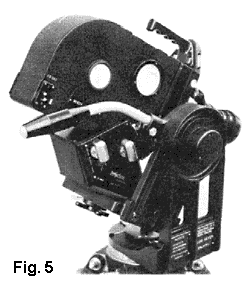
The rather well known tendency for the
Eclair NPR to want to fall forward when tilted downward, due to the high
center of gravity compared to other cameras, actually led to the development
of the Fluid 7 tripod head by Ronford (fig. 5). The heads cantilever design
kept the weight of the camera centered as it was tilted upwards or downwards.
The sophisticated design of the Fluid 7 made the head quite heavy and rather
expensive. Unlike their video counterparts of today, most film camera tripods
in years past did not have a counterblance spring. If you tilted the camera
too far forward and forgot to lock it it just kept going. Sometimes even
flipping over the
tripod!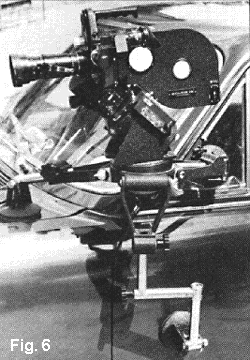
Ronford also offered their Ronford Car
Mount (fig. 6). The kit consisted of a ball base, leveling ball and three
suction cup attachments. The picture details a typical setup using the Eclair
NPR as the victim...I mean, camera.
Several companies took another approach
to camera support by designing body pods and braces. The Model 1125E
Leo-Pod (fig.7) made by Leopold Enterpises Inc. was probably the most elaborate
of them all. It featured a full-body harness that allowed the cameraperson
to practically "wear" the camera.
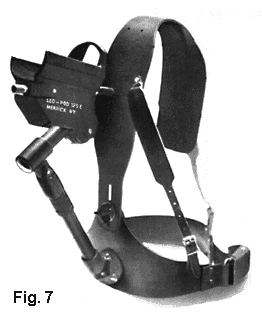 A custom cradle,
similar in style to the NPR's own tripod mount, held the camera securely
in place. There was a fully adjustable telescoping rod in the front that
distributed most of the NPR's weight to the operators waist. The advantage
of using a body brace like the Leo-Pod is that both of your hands remained
free to focus and zoom, take light readings, etc. Besides Leopold, Cine 60
also made a body brace for the NPR.
A custom cradle,
similar in style to the NPR's own tripod mount, held the camera securely
in place. There was a fully adjustable telescoping rod in the front that
distributed most of the NPR's weight to the operators waist. The advantage
of using a body brace like the Leo-Pod is that both of your hands remained
free to focus and zoom, take light readings, etc. Besides Leopold, Cine 60
also made a body brace for the NPR.
While all of these grips and braces are
rather nice. Finding one today is another matter. Some of the firms that
do repairs on the NPR claim to offer their version of a grip. I have asked
each of them to provide a photo and I will include them as soon as I have
them. In one of my old filmmaking books there was a photo of a cameraman
holding an NPR with what was
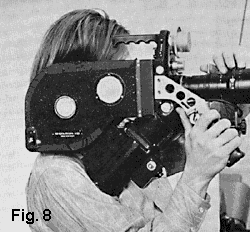 described as
a custom grip (fig. 8). That got me to thinking about making my own
custom hand grip for my NPR. I posted my thoughts on one of the newsgroups
in the hopes that others may have had the same inclination and might be willing
to share their results. I soon got a reply from a Steve Parker, at the University
of Illinois, who said he had made such a grip for his NPR with parts from
an old, discarded Sony video camera...the DXC-1610. Well, I knew I had owned
a 1610
described as
a custom grip (fig. 8). That got me to thinking about making my own
custom hand grip for my NPR. I posted my thoughts on one of the newsgroups
in the hopes that others may have had the same inclination and might be willing
to share their results. I soon got a reply from a Steve Parker, at the University
of Illinois, who said he had made such a grip for his NPR with parts from
an old, discarded Sony video camera...the DXC-1610. Well, I knew I had owned
a 1610 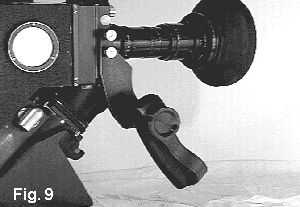 so I
dug around until I came up with what was left of it. He was right. The plastic
grip from that camera would make an excellent substitute for what was Eclair
factory stock.
so I
dug around until I came up with what was left of it. He was right. The plastic
grip from that camera would make an excellent substitute for what was Eclair
factory stock.
My final version can be seen, here (fig.
9). You will note that my grip is also attached to the camera using the very
same two screw holes that are on the basic NPR. The grip's mounting arm is
made from 3/16" aluminum plate. Unlike the unit shown in Fig. 8, it has been
shaped to conform to the side of the NPR housing so that it does not interfer
with the rotation of the lens turret. While the plate does cover the adjustment
knob for the variable shutter, for the limited number of times I need to
get to it, it is easy enough to remove the grip by simply undoing the two
thumb
nuts.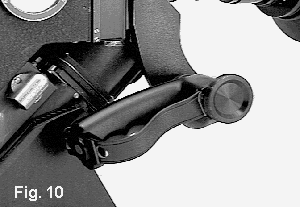
The old Sony hand grip used a heavy-duty,
steel rosette with a large locking knob to secure it to the side of the camera.
This allowed you to adjust the grip's angle to match that of your hands position.
This feature comes in very nicely when using it with the Eclair NPR. When
you have the camera on your shoulder you would adjust the handle towards
the front at about 45 degrees. However, if you plan on shooting from the
hip you would want to readjust the hand grip downwards and to the rear (fig.10).
One note, here, on the fabrication. I have found that, if you have your metal
pieces bead-blasted, first, they will take the paint much more readily. I
did this with the bracket for the grip and when I needed to repaint my NPR's
handle. Just a thought.
I'm sure there are others out there who
have found their own way of dealing with this issue. I'd be interested in
seeing photos of your designs and I'll gladly post them on this site.

